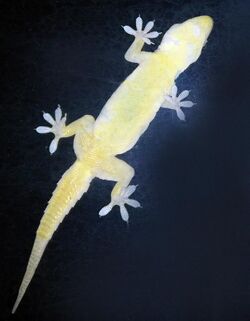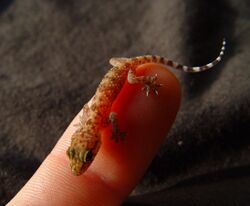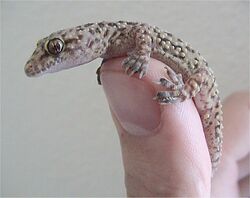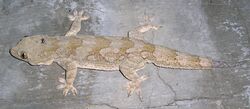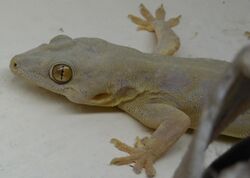Biology:Hemidactylus
| Hemidactylus | |
|---|---|
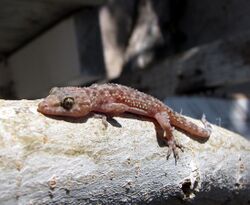
| |
| Mediterranean house gecko (Hemidactylus turcicus) | |
| Scientific classification | |
| Domain: | Eukaryota |
| Kingdom: | Animalia |
| Phylum: | Chordata |
| Class: | Reptilia |
| Order: | Squamata |
| Family: | Gekkonidae |
| Subfamily: | Gekkoninae |
| Genus: | Hemidactylus Oken, 1817[1] |
| Type species | |
| Gecko tuberculosus Raddi, 1823
| |
| Diversity | |
| 176 species, see text | |
| Synonyms | |
|
In alphabetical order:
| |
Hemidactylus is a genus of the common gecko family, Gekkonidae. It has 176 described species, newfound ones being described every few years. These geckos are found in all the tropical regions of the world, extending into the subtropical parts of Africa and Europe. They excel in colonizing oceanic islands by rafting on flotsam, and are for example found across most of Polynesia. In some archipelagoes, cryptic species complexes are found.[2] Geckos like to live in and out of houses. They have been introduced to Australia .[citation needed]
The species are typically known as house geckos, due to their readiness to adapt to and coexist with humans, and can be easily encountered in human habitations. This genus was originally established by Lorenz Oken in 1817 for the species at that time known as Hemidactylus tuberculosus, and now described as the tropical house gecko (Hemidactylus mabouia).[2]
This species is closely related to the genus Gehyra, which belongs to the same family in Gekkonidae.
Evolution
The origin of the genus Hemidactylus is still unclear as the higher level phylogeny is not well resolved. Moreover, much of the diversity in this group still remains to be discovered.
Feces
A house gecko will usually confine its excretions to one area of a house. This is sometimes considered a nuisance by home owners, and may stain certain surfaces.[3] The feces are approximately five (5) millimeters in length, two (2) millimeters wide, and dark brown (almost black) in color.
Description
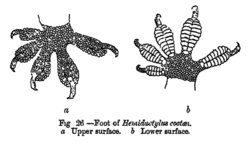
The dorsal lepidosis is either uniform or heterogeneous. The pupil of the eye is vertical. Males have pre-anal or femoral pores. Each finger or toe has a slender distal clawed joint, angularly bent and rising from within the extremity of the dilated portion.[4]
The fingers and toes are free, or more or less webbed, and dilated; underneath they bear two[citation needed] rows of lamellae in a pattern resembling a paripinnate compound leaf.[4] This leads to their other and more ambiguous common name, "leaf-toed geckos", used mainly for species from South Asia and its surroundings to prevent confusion with the many "leaf-toed" Gekkota not in Hemidactylus.
Some members of the genus, such as H. platyurus, are able to run quadrupedally across water by a partially surface tension-dependent mechanism distinct from the bipedal gait of basilisks.[5]
Communication
Like many other gecko species, species in the genus Hemidactylus are able to communicate with distinct vocalizations. Depending on the species, their vocalizations range from quiet clicks to short squeaks and chirps. For example, the Asian common house gecko (Hemidactylus frenatus) is notable for its distinctive chirping.
Species
Phylogeny
The following phylogeny is from Pyron, et al. (2013),[10] and includes 47 Hemidactylus species. Hemidactylus is a sister group of Cyrtodactylus.[10]
| Hemidactylus |
| |||||||||||||||||||||||||||||||||||||||||||||||||||||||||||||||||||||||||||||||||||||||||||||||||||||||||||||||||||||||||||||||||||||||||||||||||||||||||||||||||||||||||||||||||||||||||||||||||||||||||||||||||||||||||||||||||||||||||||||||||||||||||||||||||||||||||||||||||||||||
Similar genera
References
- ↑ Dahms Tierleben. www.dahmstierleben.de
- ↑ Jump up to: 2.0 2.1 2.2 Lizards of the World (2004): Hemidactylus. Version of 2004-FEB-08. Retrieved 2009-APR-04.
- ↑ "House Geckos". http://citybugs.tamu.edu/factsheets/household/misc-house/ent-2006/.
- ↑ Jump up to: 4.0 4.1 Boulenger, G.A. (1890). The Fauna of British India, Including Ceylon and Burma. Reptilia and Batrachia. London: Secretary of State for India in Council. (Taylor and Francis, printers). xviii + 541 pp. (Genus Hemidactylus, p. 82). Fulltext at the Internet Archive
- ↑ Nirody, J. A.; Jinn, J.; Libby, T.; Lee, T. J.; Jusufi, A.; Hu, D. L.; Full, R. J. (2018). "Geckos Race Across the Water's Surface Using Multiple Mechanisms". Current Biology 28 (24): 4046–4051.e2. doi:10.1016/j.cub.2018.10.064. PMID 30528580.
- ↑ Angarwal I, Giri VB, Bauer AM (2011). "A new cryptic rock-dwelling Hemidactylus (Squamata: Gekkonidae) from south India". Zootaxa 2765: 21-37. (Hemidactylus graniticolus, new species).
- ↑ Jump up to: 7.0 7.1 Beolens B, Watkins M, Grayson M (2011). The Eponym Dictionary of Reptiles. Baltimore: Johns Hopkins University Press. xiii + 296 pp. ISBN:978-1-4214-0135-5. (Hemidactylus greeffii, p. 107; Cyrtodactylus malcolmsmithi, p. 247).
- ↑ "Hemidactylus greeffii ". The Reptile Database. www.reptile-database.org.
- ↑ Henle K, and Böhme W (2003). "A new species of Hemidactylus (Squamata: Gekkonidae) from West Africa, and comments on species hitherto confused with H. muriceus ". African Journal of Herpetology 52 (1) 23-38. (Hemidactylus pseudomuriceus, new species).
- ↑ Jump up to: 10.0 10.1 Pyron, R Alexander, Frank T Burbrink and John J Wiens. 2013. A phylogeny and revised classification of Squamata, including 4161 species of lizards and snakes. BMC Evolutionary Biology 2013 13:93. DOI: 10.1186/1471-2148-13-93
11. The Dragon Blood Tree Facts – The Amazing Dragon’s Blood Tree
External links
Wikidata ☰ Q747278 entry
id:Cecak bcl:tabili
 |
